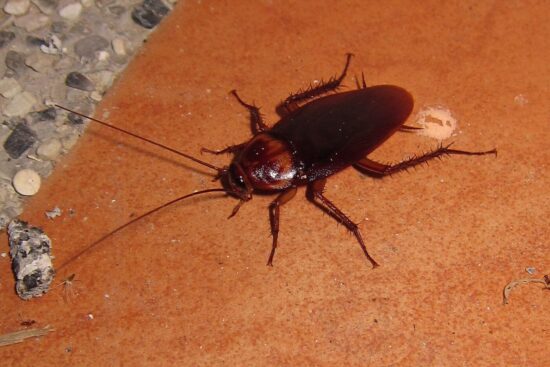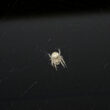Ever spotted a bug scurrying across your floor and wondered whether you’re dealing with a cricket or a cockroach? You’re not alone! These two insects look pretty similar at first glance, especially when they’re zooming away from you. Both are brown or black, have six legs, and seem to appear at the worst possible times.
But here’s the thing: knowing which pest you have actually matters. Crickets and cockroaches need totally different approaches when it comes to getting rid of them. Plus, cockroaches can spread diseases, while crickets are mostly just annoying with their loud chirping.
The good news? Once you know what to look for, telling these bugs apart is actually pretty easy. Let’s break down all the key differences so you can identify exactly what’s sharing your space.
1. Body Shape and Structure
One of the differences between crickets and cockroaches is how their bodies are shaped. Crickets have bodies that look round and tube-like, almost like a small cylinder. When you look at them from the side, they appear chunky and full.
Cockroaches, on the other hand, are built completely different. Their bodies are flat and oval-shaped, kind of like someone squished them from top to bottom. This flat design helps them squeeze into tiny cracks and crevices, which is why they’re so good at hiding.
Think of it this way: if a cricket is shaped like a hotdog, a cockroach is shaped like a hamburger patty. Once you notice this difference, you’ll never mix them up again.
2. Size Differences
When it comes to size, both bugs can grow to about the same length, usually somewhere between 1 and 2 inches. But here’s where it gets interesting: crickets and cockroaches carry their size very differently.
Crickets might be a bit smaller on average, measuring closer to 1 to 1.5 inches. However, they stand much taller off the ground because of their big, bent back legs. So even though they might be shorter in length, they look bigger and bulkier.
Cockroaches tend to max out at around 2 inches, with some species getting even larger. But because they hug the floor with their flat bodies, they often appear smaller than they actually are. It’s all about perspective!
3. Color Variations
Color is another helpful clue when you’re trying to figure out what kind of bug you’re looking at. One of the differences between crickets and cockroaches is the variety of colors they can be.
Crickets show up in several colors: red, brown, black, and even bright green. That green color is a dead giveaway because you’ll never see a green cockroach. Some crickets are almost neon in their coloring, especially the ones that live in gardens and fields.
Cockroaches stick to earthier tones. They come in brown, gray, black, and tan shades. They often have a shiny or glossy appearance that makes them look almost wet or oily. If you see a tan or grayish bug, it’s probably a cockroach. If it’s green, it’s definitely a cricket.
4. Leg Structure and Movement
Here’s where things get really obvious. One of the differences between crickets and cockroaches is all about the legs and how these bugs get around.
Crickets have huge back legs that bend at sharp angles, kind of like a frog’s legs. These powerful legs let them jump super far and high when they feel threatened. If a bug suddenly launches itself several feet into the air, you’re definitely looking at a cricket. They can jump many times their own body height, which is pretty impressive for such a small creature.
Cockroaches don’t have jumping legs at all. All six of their legs are roughly the same size, and they usually stay tucked underneath their flat bodies. Instead of jumping, cockroaches are built for speed running. They can move fast across floors and walls, but their feet stay on the ground. No jumping whatsoever.
5. Wing Appearance
Both crickets and cockroaches have wings, but one of the differences between crickets and cockroaches is how those wings look and where they sit on the body.
Cricket wings are super obvious. You can clearly see them sitting on top of the middle section of their body. The wings are short and don’t cover the whole insect. They sit there like a little jacket that’s too small, leaving part of the cricket’s body sticking out at the bottom.
Cockroach wings are sneaky. They fold so neatly over the entire body that they almost look like they’re part of the cockroach itself. The wings cover everything from top to bottom, creating a smooth, streamlined look. If you can’t tell where the body ends and the wings begin, you’re probably looking at a cockroach.
Neither bug flies much, even though they both have wings. They’d rather run or hop around instead.
6. Sound Production
This one’s easy to spot, especially at night when everything else is quiet. Crickets are famous for their chirping sounds. Male crickets make this noise by rubbing their wings together, and they do it to attract female crickets. The sound is loud, clear, and can keep you awake if you have crickets in your house.
Cockroaches? They’re basically silent. You won’t hear any chirping, buzzing, or singing from them. The only sound a cockroach makes is a faint scratching or scurrying noise when it runs across hard surfaces like tile or wood floors.
So if you hear chirping at night, you’ve got crickets. If you hear nothing but maybe some tiny footsteps, it’s probably cockroaches.
7. Taxonomic Classification
This might sound boring, but it’s actually pretty cool. Crickets and cockroaches aren’t even closely related. They’re from completely different insect families.
Crickets belong to a group called Orthoptera, which includes grasshoppers, locusts, and katydids. All the insects in this group are known for their jumping abilities and their bent back legs. They’re basically the hopping family of bugs.
Cockroaches are part of a totally different group called Blattodea. Interestingly, termites are also in this group, which means cockroaches are more closely related to termites than they are to crickets. Who knew?
This explains why crickets and cockroaches act so differently even though they might look similar at first glance. They’re distant cousins at best.
8. Habitat Preferences
Where you find these bugs can tell you a lot about what they are. One of the differences between crickets and cockroaches is where they like to hang out.
Crickets are outdoor bugs at heart. They prefer gardens, lawns, fields, and wooded areas where there’s lots of plants and moisture. When they end up inside houses, it’s usually by accident. They got attracted to a light or wandered in through an open door. Crickets don’t really want to live in your home long term.
Cockroaches are the opposite. While some species start outdoors, many types of roaches absolutely love living inside buildings. They seek out warm, humid spots like kitchens, bathrooms, and basements. Once they get inside, they settle in and start reproducing. Cockroaches are much more likely to create a full-blown infestation in your house than crickets are.
9. Diet and Feeding Behavior
Both bugs will eat a variety of things, but their eating habits are different enough to matter.
Crickets are omnivores, meaning they eat both plants and other small bugs. They munch on leaves, seeds, fungi, and sometimes dead insects. They’re not super picky, but they do prefer fresh plant material. You’ll usually find them nibbling on vegetation outside or maybe some houseplants if they get indoors.
Cockroaches will eat literally anything. And that’s not an exaggeration. These bugs have zero standards when it comes to food. They’ll eat your leftovers, pet food, garbage, dead animals, paper, glue, soap, and even other dead cockroaches. They’re scavengers who aren’t bothered by eating gross stuff. This is part of why they can spread so many germs.
10. Health Risks and Disease Transmission
Here’s where the difference between these two bugs gets really important for your health. One of the differences between crickets and cockroaches is how dangerous they can be.
Crickets are pretty harmless. They don’t carry diseases that make people sick. Sure, they might nibble on fabric or paper if they’re hungry, but they’re not bringing dangerous germs into your home. The worst thing about crickets is the noise and maybe some minor property damage.
Cockroaches are a whole different story. These bugs are nasty when it comes to spreading illness. They carry 33 different types of bacteria on their bodies, including Salmonella and E. coli. They also spread parasitic worms and other germs that can make you seriously sick. When cockroaches walk across your counters or food, they leave behind contaminated droppings and saliva that can cause food poisoning and infections.
The takeaway? Crickets are annoying but safe. Cockroaches are genuinely gross and can harm your health.
11. Allergen Potential
Even if you don’t get sick from germs, both bugs can cause allergy problems for some people. But again, one of the differences between crickets and cockroaches is how severe those allergies can be.
Cockroaches are major allergy triggers. Their body parts, poop, and spit contain proteins that cause allergic reactions and asthma attacks in many people. Studies show that 63% of homes in the United States have cockroach allergens floating around, even in houses that don’t currently have a roach problem. The allergens stick around in dust and furniture long after the bugs are gone.
Cricket allergies exist, but they’re way less common and usually much milder. Most people only react to crickets if they eat them (yes, cricket flour is becoming a thing) or handle them a lot. Interestingly, crickets contain some of the same proteins as cockroaches, so people who are allergic to roaches might also react to crickets. But overall, cricket allergies are nowhere near as widespread or serious.
12. Lifespan and Reproduction
How long these bugs live and how fast they multiply makes a huge difference in how hard they are to control.
Crickets have pretty short lives. Most crickets only live for about 8 to 10 weeks total. They go through three stages: egg, nymph (baby), and adult. The whole process happens fairly quickly. While crickets do reproduce, they don’t create massive populations like some other pests.
Cockroaches live way longer and reproduce like crazy. German cockroaches can live for 100 to 200 days, while American cockroaches can survive for 1 to 2 years. But here’s the scary part: a single German cockroach and her babies can produce 300,000 more cockroaches in just one year. That’s why roach problems get out of control so fast.
Female cockroaches create egg cases that hold anywhere from 10 to 50 eggs each. They can make multiple egg cases throughout their lives. This is why professional pest control is often necessary for cockroach infestations. You can’t just squash the ones you see and call it a day.
13. Behavioral Patterns
Both crickets and cockroaches are night owls. They’re nocturnal, which means they’re most active when it’s dark outside. This is why you usually see them scurrying around late at night when you flip on a light.
But how they react to humans is very different. Crickets are shy and will hop away quickly when they sense someone nearby. They rarely bite people, and even if they did, their bite is too weak to break human skin. Crickets just want to escape and hide.
Cockroaches run away too, but they’re more likely to bite if they’re desperate for food. Roach bites show up as raised red bumps on your skin. It doesn’t happen all the time, but it’s definitely possible in homes with heavy infestations. Cockroaches are also brave enough to stick around kitchens and bathrooms even when people are nearby, as long as they have hiding spots to duck into.
14. Why Proper Identification Matters
Now you know all the major ways to tell crickets and cockroaches apart. Understanding these differences isn’t just about satisfying your curiosity. It actually helps you deal with pest problems the right way.
If you have crickets, you probably just need to seal up entry points, turn off outdoor lights that attract them, and maybe catch the few that got inside. It’s usually a quick fix that doesn’t require professional help.
If you have cockroaches, you’re facing a tougher situation. You’ll need thorough cleaning, elimination of food sources, sealing of cracks and holes, and possibly professional extermination. The health risks are higher, and the problem can spiral out of control faster.
So the next time you see a brown bug zooming across your floor, take a second to check: Does it jump? Is it shaped like a cylinder or a pancake? Do you hear chirping? The answers will tell you exactly what you’re dealing with and what steps to take next.
Nobody wants bugs in their house, but at least now you can tell the harmless chirpers from the disease-spreading invaders!


